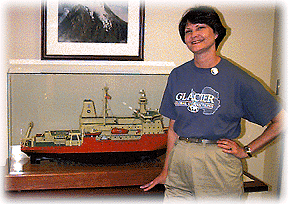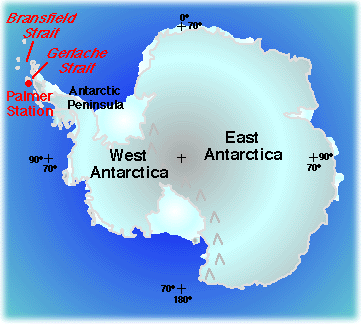
|
|



JGOFS: Joint Global Ocean Flux Study
Investigator: David M Karl, University of Hawaii at Manoa
I worked on the Palmer Long Term Ecological Research (LTER) Program, a project involving ecosystem dynamics in Antarctica. It's one of 18 separate LTER programs around the globe. These projects are designed to help us understand ecological processes and interactions on longer time scales (decades to centuries). The researchers in the Palmer LTER are looking at the effect the annual advance and retreat of sea ice has on the Antarctic marine ecosystem. This is a BIG undertaking: Antarctic sea ice grows from its minimum summer extent of around 4 million square kilometers to a winter maximum of nearly 20 million square kilometers! This huge annual advance and decay of sea ice is a major controlling factor in ecological processes ranging from the growth of tiny marine plants (phytoplankton) to the breeding success of seabirds.
Because this is a big project, there are different groups within it focusing on its various components. The group I worked with is concentrating on the role of microorganisms, such as unicellular algae and bacteria, in Southern Ocean habitats. These tiny creatures are very important! They are largely responsible for the production and decomposition of organic matter. The microorganisms that undergo photosynthesis help remove carbon dioxide, CO2, from the atmosphere to the ocean. Photosynthetic organisms need CO2 to make all the organic materials necessary for their growth and maintenance. As they take CO2 out of the sea water for their own growth, the ocean water has less and less CO2 in it. The ocean and air work together to maintain a balance of CO2. When the organisms use up some of the CO2 in the ocean, CO2 moves from our atmosphere into the ocean. When these organisms die and sink, they transport carbon and energy to intermediate ocean depths. As they undergo these (and other) processes, they play a big role in controlling ocean chemistry.
To do our work, we collected data on marine chemistry and on organisms such as phytoplankton, krill (very small marine animals near the base of the food chain - and a major food source for the big whales), seabirds, and marine mammals. We hope to learn about natural cycles in phytoplankton and microbial ecology, and how these cycles affect the organisms that depend on phytoplankton as a food source. With this information, we can help predict how the ecosystem may react to altered conditions caused by environmental changes, whether natural or human-induced.
The results of this research have been compared to those from a very
different area - Hawaii! The contrast in the physiology of
bacterioplankton from these two quite distinct regions will help aid our understanding of the role they play in the microbial community.

Besse
collected samples from the waterways around the Antarctic
Peninsula and had the opportunity to visit Palmer Station.
Visit
Besse's Arctic Field Project and Journals

Be sure to check out the images in the journal entries!
February 1998
January 1998
July 1997
| Su |
Mo |
Tu |
We |
Th |
Fr |
Sa |
| -- |
-- |
1 |
2 |
3 |
4 |
5 |
| 6 |
7 |
8 |
9 |
10 |
11 |
12 |
| 13 |
14 |
15 |
16 |
17 |
18 |
19 |
| 20 |
21 |
22 |
23 |
24 |
25 |
26 |
| 27 |
28 |
29 |
30 |
31 |
-- |
-- |
Return to top of page
|






